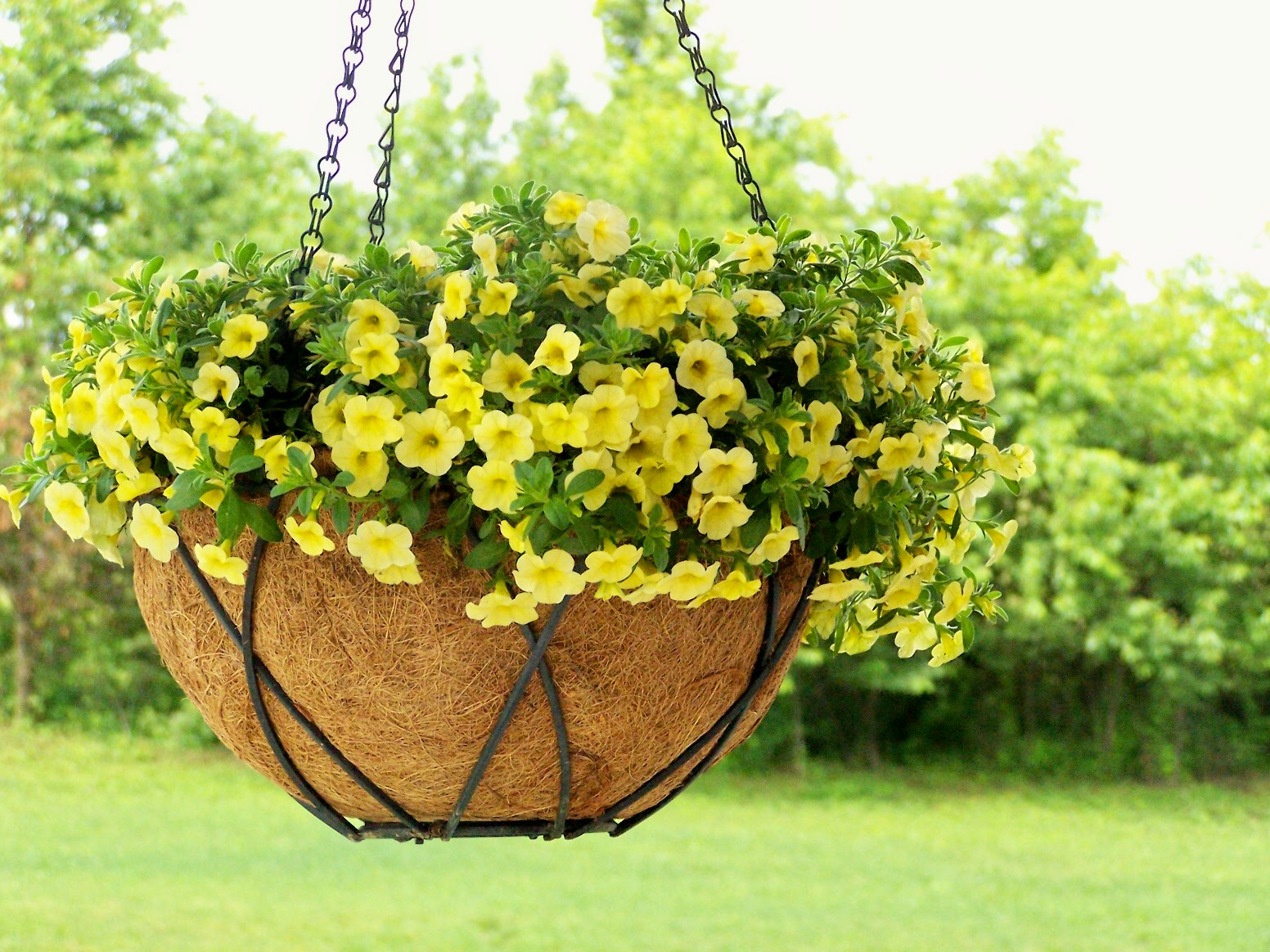Long before plastic, the main option open to gardeners who wanted to make a hanging garden was to create a moss-lined wire nest to plant summer flowering plants. This technique to contain soil and moisture was a favorite of the Victorians who wanted to bring new dimensions to gardening. Using moss as a liner is certainly more work than planting up a plastic pot, but oh, how different the end result! It is also a good recycling technique as the wire basket can last through many seasons and the moss is easy to renew. Moss baskets are not typically found for sale except perhaps at upscale garden centers and for a steep asking price. The technique is easy and it is a fun project that will set you apart from the average gardener. Here is how it is done.
You will need:
• Wire hanging basket: Use a 14- or 16-inch diameter basket, as anything smaller than 14 inches dries out too quickly and more than 18 inches gets too heavy to hang without extra reinforcing. Galvanized wire is the traditional choice but plastic coated wire will last longer. There are many styles as well as traditional baskets that can be lined with moss.
• Long fiber sphagnum moss: This is the main choice but Oregon green moss and sheet mosses will work as well.
• Fertilizer: A slow-release product such as Osmocote* 14-14-14 can be mixed in the soil to feed the plants all summer. Because there is little soil compared to roots in hanging baskets, it is important to ensure that the plants are nourished all season. Using a slow-release fertilizer is easier than remembering to liquid feed every other week all summer long.
• Soil moist water retention beads: These are small granules that expand when moistened so they help to reduce watering. Mossed hanging baskets dry out very quickly because they are exposed on all sides. In the heat of the summer, it is not unusual to water moss baskets twice a day. The moisture retention beads soak up water and slowly release it into the soil. They work well in any container situation.
• Plants: Keep in mind the wind, sun/shade and the colors of the house, porch, etc. Good choices for hanging basket plants are silver licorice (heliochrysum petiolare), ivy, trailing lobelia, sweet alyssum, the tapiens series of verbena, trailing petunias such as supertunias and surfinias, hanging begonias, trailing fuchsias, diascia, nemesia, calibrachoa million bells, bacopa, and impatiens. Plants like dwarf heliotrope, upright begonias or bidens are good choices for the center of the basket. In choosing plants, remember to keep in mind the exposure of the area where your basket will hang.
• Design: Let your creativity flow! Moss hanging baskets are viewed from different vantage points and often from below so be sure to plant the sides and the lower area of the basket rather than placing everything in the top area. Mix colors for balance and interest. Foliage helps to balance and contrast the colorful flowers and texture is as interesting as bloom. Think also of fragrance when you plant your basket. Moss baskets look lovely on a porch or near an entrance so use sweet alyssum or a lemon-scented herb to add a hint of aroma.
Maintenance
Watering is the single most important factor for successful hanging baskets. Check the soil daily. If you can’t reach the plant to do this, assume that the basket needs water every day during the hot summer days. It is difficult to over water a moss basket since the water runs out freely. Using a watering wand to extend the reach makes the task easier but always water slowly to drench the soil until the water drains out the bottom. Some moss may fall off in the early days but soon the growing roots will tie the moss to the frame and the soil. Avoid choosing a windy or hot afternoon sun location.
Technique
• First: Mix together the soil, soil moist granules and the fertilizer. Moisten mixture and set aside. Be aware that there are soils sold that have all of this mixed together in the package. You may want to wear protective gloves, especially if your skin is sensitive. Soak the moss in a bucket of warm water for 15-30 minutes and gather all the plants that you will need for the project. Working at the end of a table allows you the best vantage point to see the basket from all sides. Stand the wire frame up on a clay flowerpot so that it is at a comfortable height to see and assemble the basket. This also allows you to have both hands free to work.
• Second: Take a handful of moss and wring out as much of the water as you can. Beginning on the bottom, press the moss against the frame from the inside using one hand on each side of the frame. Continue to build the moss wall, one handful at a time so that you have an even layer approximately 1½ to 2 inches thick. Consistency is important because if you make the walls too thin, the soil will not be held in the basket; if too thick, there will not be enough room for the soil and the growing plants. Put three small plants such as ivy or bacopa around the bottom area so that the roots poke into the mossed frame. This makes the basket look more interesting when viewed from below. Begin to add the soil. A note here about plastic liners: Although many experts advise using plastic sheet liners or landscape fabric, this does not work well in the case of the moss hanging basket because the moss will never make contact with the roots. Do not use a liner in any moss basket that you want to plant through the sides. Also the plastic tends to look unsightly if it is visible. Water retention beads are a better way to retain moisture.
Start to moss from the bottom
• Next: Continue to add the moss along the bottom and up the sides of the basket an inch or two. Add plants in the lower third of the basket, using odd numbers and varying the plant material. Make sure the roots are well inside the basket so that they make contact with the soil. Add soil and continue on up the sides of the basket repeating the process but staggering the plants so that they do not overlap the ones below.
• Last: Continue the moss up to and over the rim of the basket; add soil almost to the rim as it will settle with watering and use trailing plants such as lobelia, bacopa, or million bells as edging, with more upright plants in the center. Trim off any blooms so that the plants will fill out. Attach the hangers securely and place the basket in its final place immediately so that it does not get crushed. Water very well but slowly so the basket is not disturbed. As the plants root out, the moss basket will be more tolerant of heavy watering.
Tips for success!
1. Be consistent as you apply moss, being sure to maintain no more than 2 inches in depth.
2. Mix time-release fertilizer (and moisture-retaining crystals if you choose) into soil and then add soil to basket—or use a soil mix that has everything added for you.
3. Use small plants or rooted cuttings.
4. Water well and slowly, lest you wash away the contents of your basket.
5. Location, location, location! Your moss basket will hold up better if you avoid a hot or windy location.
6. Don’t forget to deadhead and trim plants that become leggy.
*Osmocote is the registered trade name for the original slow-release fertilizer developed in the 1960s by Scott. There are several formulations but the 14-14-14 is the recommended ratio for container plants as it will release over at 3-4 month period at 70 degrees.
Susan Pezzolla, Master Gardener Coordinator, Horticulture Educator. Cornell University Cooperative Extension. 24 Martin Road, Voorheesville, NY.





